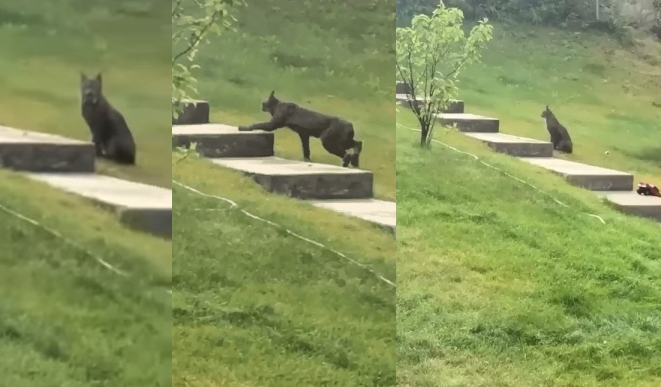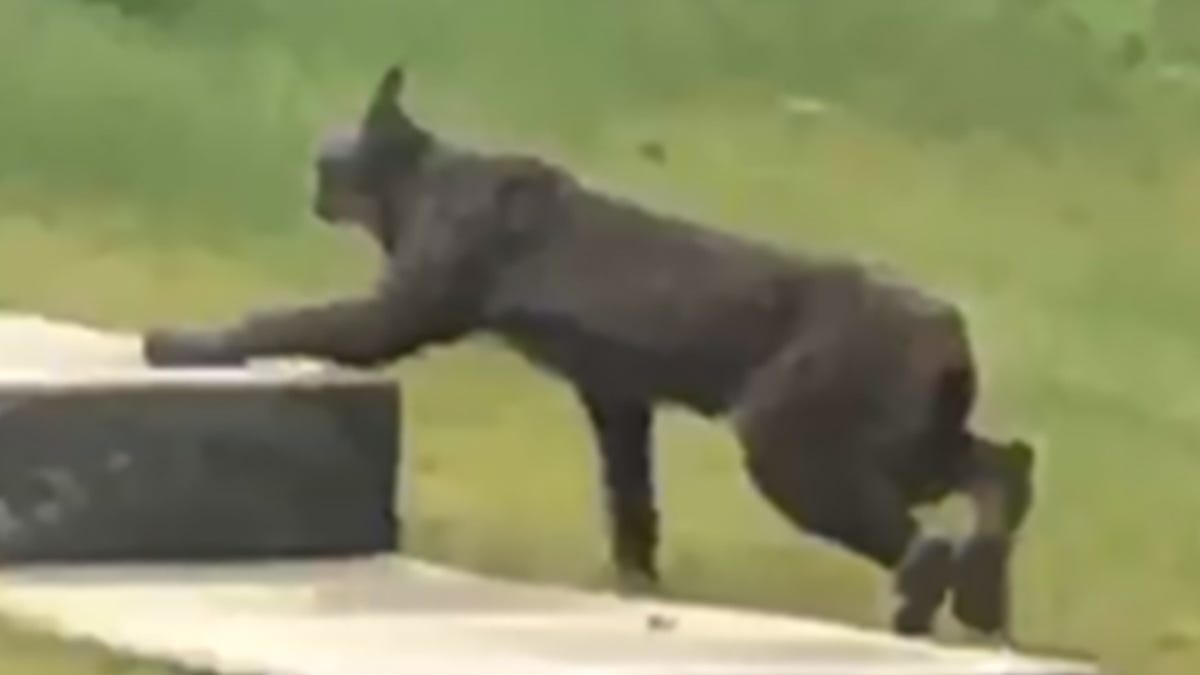A Winter Encounter That Changed Everything
It began as an ordinary December afternoon in the quiet snow-covered wilderness of Canada. A local wildlife enthusiast, out for a routine trek, noticed movement at the tree line—a graceful shadow slipping through the frost. At first glance, it appeared to be a lynx, a familiar symbol of the northern forests. But as the creature stepped into a shaft of pale winter sunlight, its fur gleamed not with the usual silvery hues of the Canada Lynx, but with a deep, velvety darkness.
The hiker instinctively reached for their phone, capturing a few seconds of footage that would soon ripple through the scientific community. What they had recorded was the first confirmed sighting of a melanistic Canada Lynx—a rare, possibly one-of-a-kind specimen that had never before been documented on camera.
Within days, the clip had spread across research networks and wildlife forums, sparking equal measures of astonishment and debate. For scientists and nature lovers alike, this brief encounter opened a new chapter in our understanding of one of North America’s most elusive predators.

The Legend of the Shadow Lynx
Long before science began to analyze coat pigmentation, Indigenous and northern folklore had already whispered about a mysterious dark lynx known as the Shadow Cat. Hunters and trappers spoke of a creature that moved without sound, blending seamlessly into twilight. According to these tales, catching a glimpse of the Shadow Lynx was considered a sign of protection—or, depending on the storyteller, an omen to tread carefully in the wilderness.
In some legends, this dark feline was not a separate animal at all but a spirit form of the Canada Lynx, appearing only to those who respected nature’s balance. Its black coat symbolized endurance and adaptability through harsh winters—a creature that could thrive even when light was scarce.
While modern science often approaches such myths with skepticism, they remain a fascinating lens into how early peoples observed and interpreted unusual natural phenomena. What was once myth has now met reality, as the melanistic lynx transitions from campfire story to verifiable species variation.

What Is Melanism? A Scientific Look
To understand this discovery, one must first understand melanism—a genetic trait that results in an excess of dark pigmentation in an animal’s skin, fur, or feathers. It’s the opposite of albinism, and though rare, it’s not unheard of in the animal kingdom. Black panthers, for instance, are simply melanistic leopards or jaguars, while melanistic squirrels, snakes, and even penguins have been observed in various environments around the world.
In the case of the Canada Lynx (Lynx canadensis), its typical coat is pale gray or light reddish-brown, perfectly adapted for blending into snowy forests. This makes the emergence of a dark-colored lynx particularly puzzling.
Dr. Thomas Jung, a wildlife biologist from the Yukon government who helped verify the sighting, explained in a 2022 report that this melanistic lynx was the first ever recorded of its kind. Despite earlier anecdotal mentions from hunters and locals, no photographic or physical evidence had ever existed until now.
Researchers believe the lynx’s coloration stems from a mutation in the melanin-related gene, though more genetic analysis would be required to confirm this hypothesis. Interestingly, such genetic variations can appear spontaneously, even in stable populations, as a result of environmental or adaptive pressures.

Adaptation or Disadvantage?
While the dark coat of a melanistic lynx may appear stunning, scientists are divided over whether it offers any ecological advantage. In snowy regions, darker fur might hinder camouflage, making hunting more difficult. The Canada Lynx primarily relies on stealth to catch snowshoe hares—a species whose survival depends on blending into the white winter background.
However, some biologists suggest that climate change may be subtly reshaping these evolutionary dynamics. A 2014 study published in Biological Journal of the Linnean Society proposed that as temperatures rise and snow cover diminishes, darker coats might no longer be a liability. In fact, in certain transitional seasons or forested microhabitats, they could become beneficial by aiding concealment among thawing vegetation or darker ground surfaces.
This perspective raises a fascinating question: could the melanistic lynx be a glimpse of future adaptation? While that remains speculative, it underscores how nature continues to evolve—often faster than we expect.
How Climate Change Could Influence Coat Color
The relationship between climate and animal coloration has long intrigued researchers. Warmer climates often favor darker pigmentation because melanin offers protection from UV radiation and can play a role in thermoregulation.
As Canada’s northern regions experience shorter winters and less consistent snowfall, the evolutionary balance that once favored light fur might gradually shift. Similar patterns have been observed in other animals: darker morphs of squirrels, foxes, and even wolves are appearing in regions previously dominated by lighter variants.
That said, the appearance of a single melanistic lynx doesn’t necessarily signify a trend. It could simply be a rare genetic anomaly. Yet, it does serve as an important reminder that environmental changes—whether subtle or dramatic—can influence traits that have persisted for millennia.

Cultural Significance Across Time and Place
The idea of black or dark-colored animals often holds deep symbolic meaning in cultures worldwide. From ancient mythology to modern literature, creatures with dark coats are alternately seen as symbols of mystery, transformation, or resilience.
In Canadian Indigenous stories, animals like the lynx are revered as guardians of secrets and knowledge. Their sharp vision and silent movement represent intuition and patience. The sighting of a black lynx, therefore, resonates beyond science—it connects to long-standing narratives about the unseen forces of nature.
Rather than viewing myth and science as opposites, this discovery invites a more integrated perspective. Folklore, after all, often arises from real observations passed down through generations. It reflects humanity’s ongoing effort to interpret rare phenomena before the age of genetics and molecular biology.
Documenting the Discovery
The original video, filmed in 2022 and later confirmed by researchers, shows the lynx walking calmly across a snow-covered road. The contrast between its dark coat and the white surroundings makes the footage both visually striking and scientifically valuable.
Following verification, the Yukon government and wildlife experts emphasized the importance of non-invasive observation. They discouraged attempts to track or capture the animal, focusing instead on promoting respectful coexistence and continued monitoring through camera traps and citizen science programs.
This approach aligns with modern wildlife ethics, prioritizing the animal’s wellbeing while still advancing understanding of rare genetic expressions in natural populations.

Why This Discovery Matters
At first glance, the sighting of one unusual lynx might seem like a small event in the grand scheme of biodiversity. Yet, its implications are significant. It reinforces how genetic diversity—even in its rarest forms—plays a crucial role in species resilience.
Moreover, it demonstrates the power of modern technology in documenting fleeting natural phenomena. A simple smartphone video became the key to identifying a scientific first, reminding us how accessible tools can contribute to major discoveries when paired with curiosity and respect for nature.
From an ecological perspective, this event encourages renewed study into how environmental shifts influence species adaptation. From a cultural perspective, it reawakens ancient stories, bridging traditional knowledge with contemporary science.
Reflections on Human Curiosity
The story of the melanistic Canada Lynx is, in many ways, a story about human curiosity itself. Every time an unexplained phenomenon surfaces—from mysterious lights in the sky to dark-furred animals in snowy forests—it sparks the same impulse that has driven scientific discovery for centuries: the desire to understand.
This curiosity unites myth-makers, explorers, and scientists alike. While early storytellers might have described the lynx as a spirit of the woods, today’s researchers view it through the lens of genetics and environmental adaptation. Both perspectives, however, spring from the same wonder—a recognition that the natural world still holds countless secrets.
As the snowy landscapes of Canada continue to evolve, perhaps more sightings will follow. Whether the melanistic lynx remains a rare marvel or becomes a symbol of adaptation in a changing climate, it reminds us that nature’s diversity is vast, unpredictable, and deeply interconnected with our own sense of discovery.
Sources
-
Government of Yukon, Department of Environment. Wildlife observations and research archives (2022).
-
Biological Journal of the Linnean Society (2014). “Environmental correlates of melanism in mammals.”
-
National Geographic. “Understanding Animal Melanism: Genetics and Ecology.”
-
CBC News. “First Recorded Sighting of a Melanistic Canada Lynx Confirmed by Scientists.” (2022).
-
EverythingNowOn.com. Original report republished December 2022: “Rare Creature Caught on Camera for the First Time, Leave Scientists Stunned.”
